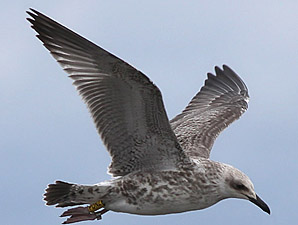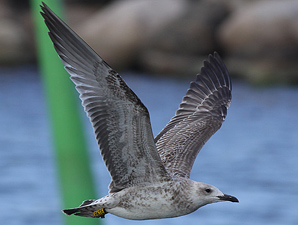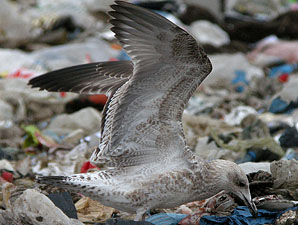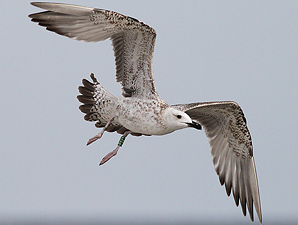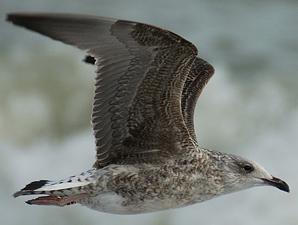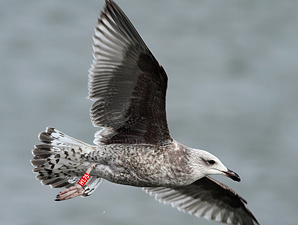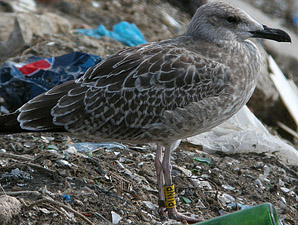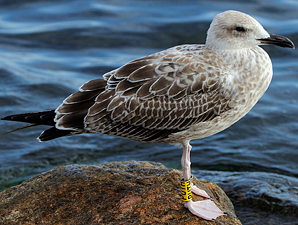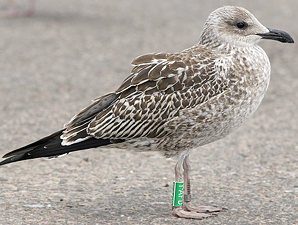 Larus cachinnans
Larus cachinnans
(last update:
Greg Neubauer
Marcin Przymencki
Albert de Jong
Mars Muusse
 sub-adult cachinnans: August
sub-adult cachinnans: August
In 2011, Chris Gibbins, Grzegorz Neubauer and Brian Small published two extensive papers in Britsih Birds, dealing with Caspian Gull. Below, you will find the content of the second paper "phenotypic variability and the field characteristics of hybrids".
The full title reads: From the Rarities Committee's files - Identification of Caspian Gull. Part 2: phenotypic variability and the field characteristics of hybrids, by Chris Gibbins, Grzegorz Neubauer and Brian Small, IN: BB 104/2011. ORDER PAPER COPY!
"we" in the text below refers to the original authors. If any errors occur in this text, please let me know and mail to marsmuusseatgmaildotcom.
PART 1: ABSTRACT & INTRODUCTION
PART 2: APPROACH
PART 3: ADULT BIRDS AND FIRST WINTER BIRDS
PART 4: DATA ANALYSIS
PART 5: VARIABILITY IN PLUMAGE (OF ADULTS)
PART 6: IDENTIFICATION OF FIRST WINTER BIRDS
PART 7: VARIABILITY IN EXTENT OF POST-JUVENILE MOULT
BELOW: PART 8 OF THE PAPER: UNDERWING PATTERN
Identification of Caspian Gull. Part 2: phenotypic variability and the field characteristics of hybrids
Underwing pattern
Plate 432 (p. 734 in BB article) shows the underwing of a selection of Caspian Gulls. The birds were all photographed in either September or October of their first calendar-year and were selected to illustrate the continuum of underwing markings. The page on this website shows underwings of ringed birds.
The most typical impression of Caspian is an underwing which is paler overall than that of Herring (or Yellow-legged) Gull. The ground colour is silvery-white, and this is overlain with a degree of brown barring and mottling. In many birds, the median underwing-coverts are paler (less well marked) than the rest, and this gives rise to a pale band across the underwing; on some birds there is also a similar band across the lesser underwing-coverts. Consequently, on the medium and darker Caspian Gulls, the pattern is rather contrasting and so can be similar to the banding seen on some Yellow-legged Gulls. While the underwing of Herring Gull varies in overall darkness, the key point is that it is much more uniform, with little contrast between the darker and paler feathers. On Caspian Gull the long rear axillaries are often (but not always) the most strongly marked part of the underwing, although the actual pattern varies: some birds have heart-shaped spots, others coarse barring and some fine barring on the axillaries. The wing fold line along the upper flank is often contrastingly pale.
PUSZ is the darkest example we have of a proven Caspian Gull (it was ringed as a chick in Ukraine). The brown on the underwing of such birds is very cold and dark in tone and the barring is very dense, producing an underwing that is at least as dark as typically seen on Yellow-legged Gull. If seen in Britain, such birds would most likely cause considerable debate. Notice that on some birds the dark markings are coarse and sit over a pale ground colour, while on others the feathers have a buffy-brown ground tone with paler stippling over this (i.e. the reverse pattern). Thus, while the paler Caspian Gulls separate clearly from Herring and Yellow-legged Gulls, there are no simple character traits that separate the darker birds. An important point is that there is a strong correlation between the underwing markings and the extent of streaking on the head and body. Heavily streaked birds are likely also to have relatively dark underwings, as shown by PUSZ.
Identification of 1CY birds in August and September
First-calendar-year Caspian Gulls are now turning up regularly in Britain in July and August. On such early dates the post-juvenile moult has either not begun or barely started and so these birds retain a more or less full set of relatively fresh, first-generation feathers. At this time they can look extremely different from how they appear later in the autumn and winter, when moult and wear have turned them into much more distinctive birds. Some fully juvenile Caspian Gulls can easily be overlooked by the unwary, and so are worth discussing here, even though we have not scored them quantitatively.
An extremely dark-looking, well-streaked juvenile, especially if it has heavily marked wing-coverts, may not immediately strike observers as a Caspian Gull. However, this combination of traits does occur in pure Caspian Gull, as indicated by the Ukrainian birds PUHP and PUNP. PUHP is unusual in its overall darkness (trait score 4) and heavily notched greater coverts (score 3) as well as in having a tertial pattern more like that of a Yellow-legged Gull (score 1). In fully juvenile plumage, PUHP looks rather like some Lesser Black-backed Gulls L. fuscus and in Britain may be passed off as such. However, later in the autumn such birds can become more typical-looking. PUNP also looks dark but actually is rather typical of how many fresh 1CY Caspian Gulls look. Once we accept that such Caspian Gulls occur, the identification of unringed dark individuals as this species becomes more palatable.
END OF PART 8
CONTINUE PART 9: DISCUSSION
 Larus cachinnans 2CY-5CY UKK T-001874 May 2010 - July 2013, Windheim & Deponie Pohlsche Heide - Minden, Germany.
Picture: Armin Deutsch.
Larus cachinnans 2CY-5CY UKK T-001874 May 2010 - July 2013, Windheim & Deponie Pohlsche Heide - Minden, Germany.
Picture: Armin Deutsch.  Larus cachinnans 2CY-4CY PHNN December 2012 - November 2014, the Netherlands.
Picture: Merijn Loeve, Jan Jacob de Vries, Albert de Jong, Dave van der Poel & Theo Muusse.
Larus cachinnans 2CY-4CY PHNN December 2012 - November 2014, the Netherlands.
Picture: Merijn Loeve, Jan Jacob de Vries, Albert de Jong, Dave van der Poel & Theo Muusse. Larus cachinnans 5CY V483 August 01 2010, Damhussøen, Denmark. Picture: Mikkel Holck.
Larus cachinnans 5CY V483 August 01 2010, Damhussøen, Denmark. Picture: Mikkel Holck. 